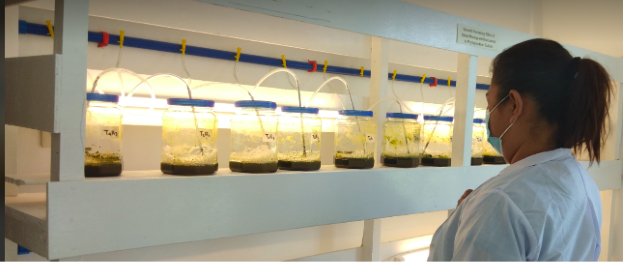A research study from Pangasinan State University, Binmaley campus headed by Dr. Shella C. Parreño revealed that Malunggay leaves extract can be used as fertilizer to enhance the growth of phytoplankton culture.
Varying concentrations (1%, 2%, 3%, 4%, and 5%) of Malunggay (Moringa oleifera) leaves extract were subjected to a range finding test to determine the best concentration of Moringa leaves extract that enhances the growth of phytoplankton (Nannochloropsis australis). It was found that lower concentrations gave the best result. “With its beneficial properties, why not use it as a growth enhancer to phytoplankton like Nanochloropsis australis to maximize its use” Dr. Shella C. Prareño – PSU Binmaley Research coordinator – said in an interview. Phytoplankton is unicellular living algae that are mostly confined just to the water surface. These microorganisms do not only account for large amounts of oxygen production on Earth but are also a source of primary food for filter-feeder invertebrates and pelagic fish species. At PSU-Binmaley Campus, this alga is used to feed the rotifers which are the food for the larvae of crabs and shrimps.
The Malunggay tree originated from India but also grows in Africa, South America, and Asia. In the Philippines, Malunggay is a common backyard vegetable and is used as a border plant on land. It is fast-growing and a hardy tree that can tolerate some degrees of drought. Malunggay is well-known for its health benefits providing vitamins, proteins, and minerals, and is commonly consumed as a food ingredient in some popular Filipino dishes like Tinolang Manok and Pinakbet. Reports on pharmacological activities of Malunggay include antimicrobial, anti-cancer, anti-tumor, and anti-diabetic among others.
An important report on the coagulant activity of powdered seeds for water purification and wastewater treatment implicates Malunggay’s benefits in the fishery industry. Now, the horizon of its utilization widens with the study from the competent researchers of Pangasinan State University- Binmaley campus, Pangasinan, Philippines. “Partnering with the Local Government Unit (LGU) of the Municipality of Binmaley and extending the results of this study to target communities, we hope that the production and commercialization of this research will open new business opportunities to our people, especially in these trying times,” Dr. Parreño said. The Research Unit of the Campus is currently propagating Malunggay branches along the banks of the fishponds of the campus.
